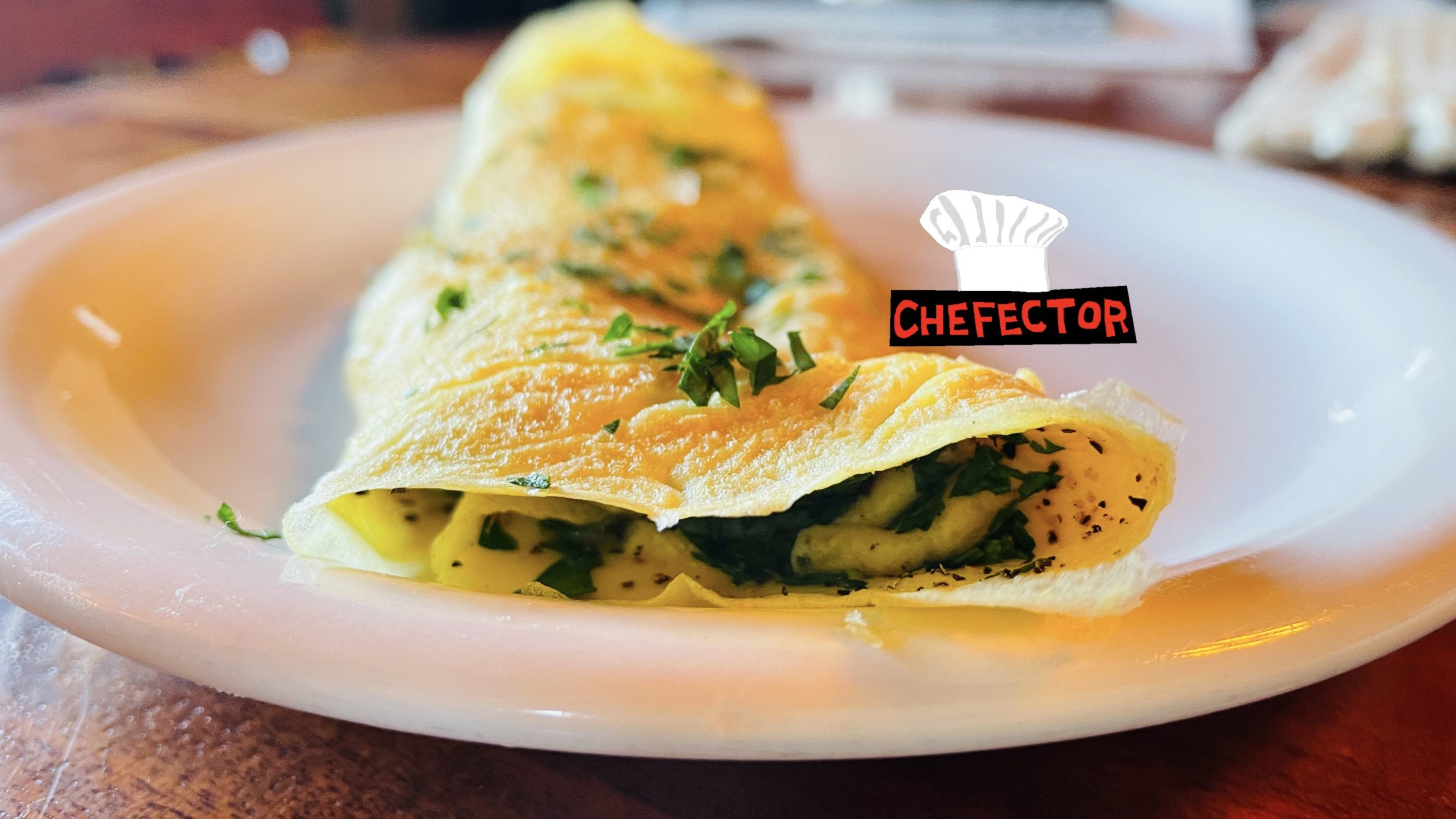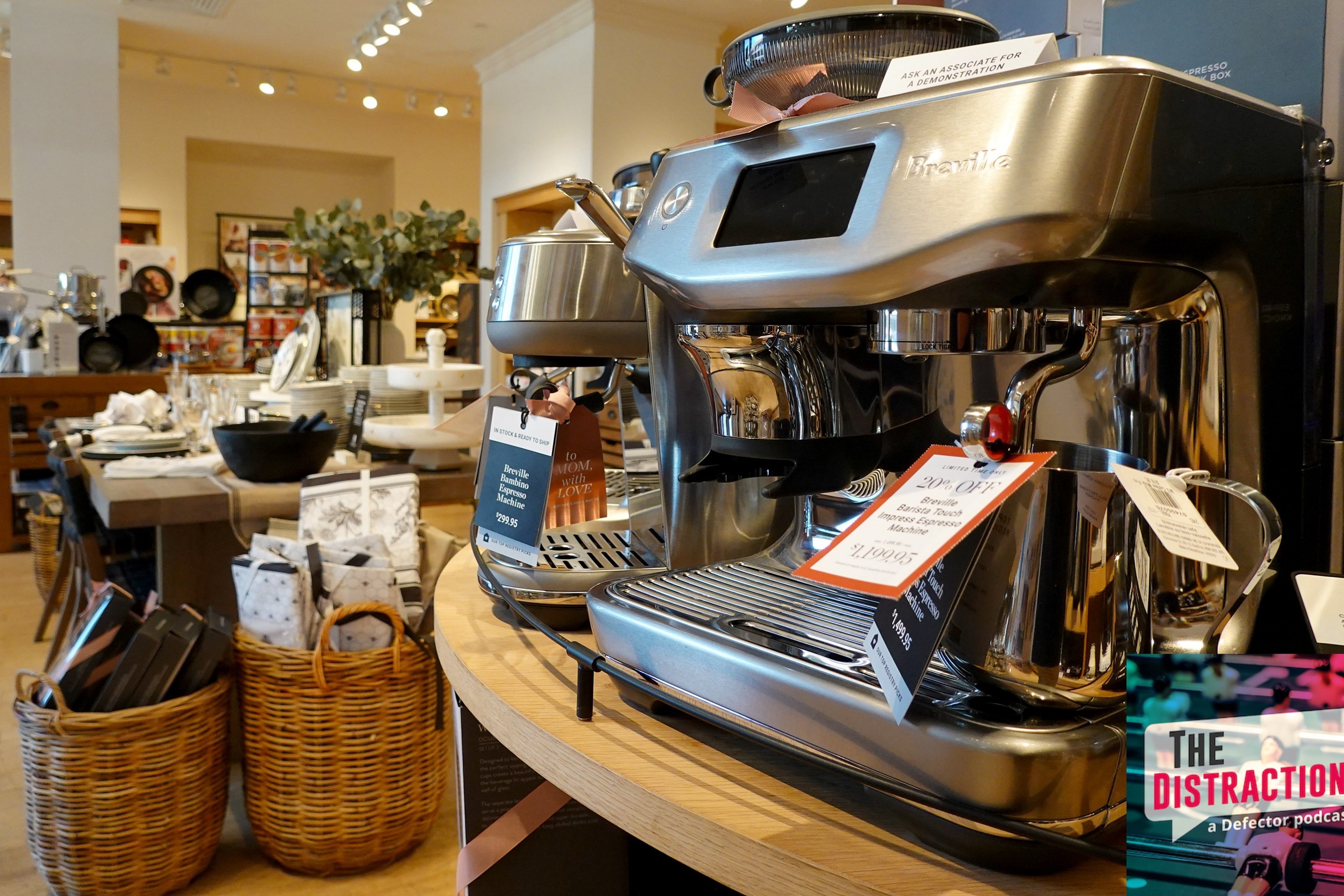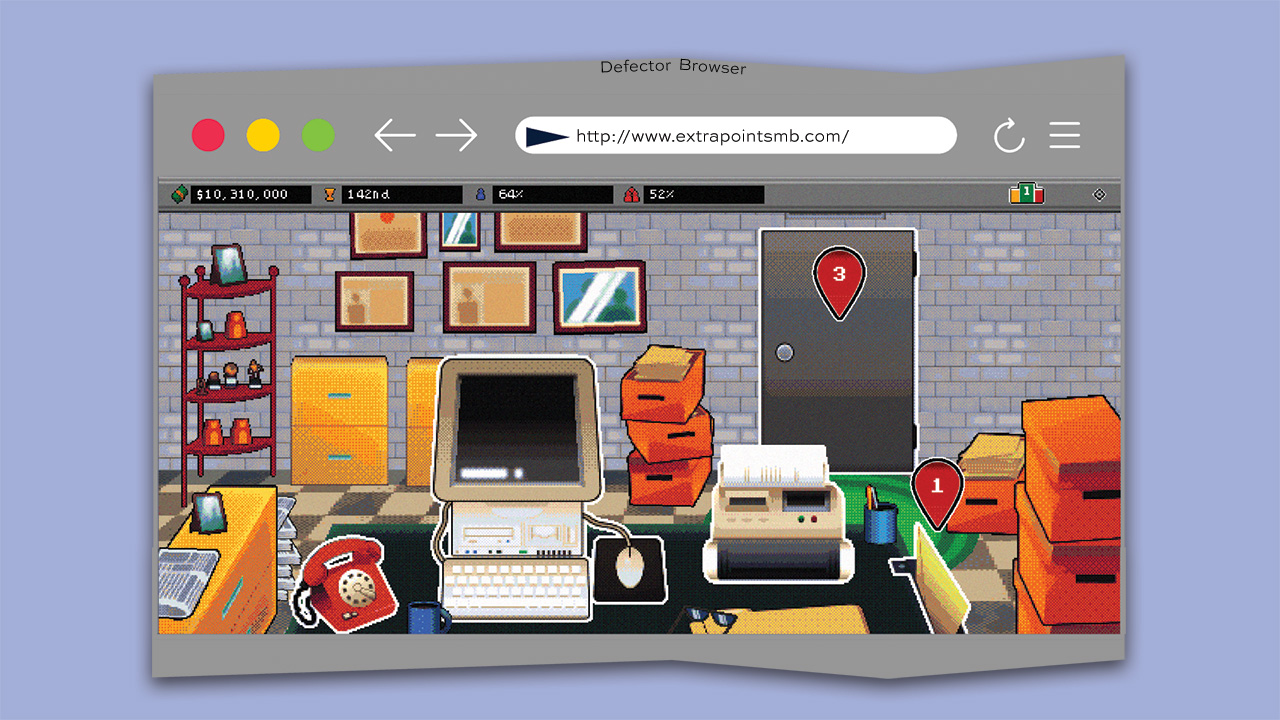So there is the big absurd American diner omelet, yeah? This is the one that is the size of your entire thorax and comes stuffed with every foodstuff anybody ever ate before noon, plus all the cheese on Earth. The one that is an entire six-course meal with a giant egg parachute folded over it. The one that Albert Brooks gets one infuriatingly teeny little bite of in Defending Your Life, before he's dragged off to, uh, defend his life.
I love the absurd diner omelet! Three lifetimes ago I wrote about how to make an absurd diner omelet for yourself, on the idea that a person might value the independence of being able to make their own one of those suckers. That's possibly even more useful instruction now, with the outer world quickly sliding back into full pandemic inoperability as the latest COVID variant lays waste to staffing schedules and supply chains; even if the diner down the street is open, and staffed, how will you get bites of the absurd diner omelet through your N95? If you want the absurd diner omelet in 2022, it's good to know how to make it for yourself.
However! There is also the other kind of omelet: the reasonable omelet. The elegant little one- or two-egg omelet that can go all the way from a vague intention to finished cooking in under 10 minutes, and can be eaten in like 90 seconds without then lapsing into hyperglycemic shock. The sleek lil' French omelet that showcases the egg and adorns it judiciously, with not more than one or two flattering things, rather than burying it under all the things. This omelet pairs wonderfully with a reasonable cup of coffee and, more importantly, with the contours of a plausible daily adult life, which generally will not have room in it for cooking 65 different breakfast foods and then fitting them all into an omelet the size of a Galapagos tortoise.
Like the absurd diner omelet, this can be a simulation of an experience of the outer world—of eating breakfast or brunch at the kind of place that does not regard adult food as an obligatory sideline to pancakes with faces on them—and knowing how to make it is a good skill to have. I have cooked, conservatively, a hundred of this kind of omelet during these bleak years of fluctuating quarantine. It's my favorite type of omelet and perhaps my very favorite genre of cooking: fast cooking in one hot pan, involving a small number of tasty ingredients of the sort a normal person likely already has in their kitchen, and just dependent enough on timing and dexterity and some meager practiced skill that it's a thing you can screw up at first and then get good at, and thus feel your powers increasing.
Let's do it. Here we go.
Here are some things that you will need.
You'll need eggs, naturally. Think of this omelet as a food for one person or, at very most, for two people who are not particularly hungry; if you want to feed more people than that, you'll need to make multiple omelets rather than a bigger one. I have a little fry pan with an eight-inch diameter that is perfect for this job (more on this in a bit); two large or extra-large eggs will make a nice thin omelet in this pan, and a nice lil' breakfast for me. (I also have a huge squircle-shaped nonstick griddle pan that can make a much larger but still nice and thin four- or five-egg omelet, which makes a nice breakfast for two people.)
Your omelet, in my opinion, should not have more than three eggs in it, unless you are using a very large skillet. If you have a tremendous Paul Bunyan appetite for eggs and cannot be satisfied with two or three of them, then I suggest simply making yourself a second omelet. Or perhaps just having some scrambled or fried eggs for breakfast.
But why, you are screaming: Why!!!!! The thing is, if you use a lot of eggs, then you are going to have a deep pool of beaten eggs in your pan; by the time all of this liquid egg has set or come close to setting, some of it will have turned rubbery, which is a bummer. Or anyway is not the goal. The goal is a thin omelet, cooked no more than necessary to hold together and withstand some gentle folding. And I will explain this no further! It is enough for me, the Food Blogger, to have said that it must be so!
You will need some cooking fat. Ideally, like in terms of your omelet's highest potential as a good-tasting thing to eat, this fat will be like half a tablespoon of good butter. On the other hand maybe the constraints of your cardiovascular deal or ethical dietary commitment forbid butter. It is also fine for this to be olive oil or whatever. Or, like, cooking spray, if you are comfortable with some way of deploying it into a hot pan later on that does not risk turning the can of spray into a flame-thrower or a bomb! Suit yourself. Personally I am not all that invested in your choice of cooking fat.
You will need salt and pepper. That can be absolutely 100-percent of what you put in your omelet, and it will be a tasty omelet (particularly if you went for butter!). If you want some other action in your omelet, you might consider a finely chopped fistful of tender, springy herbs like parsley and chives (as opposed to, like, rosemary, for the reason that within a delicate omelet rosemary will be like chewing pine-flavored matchsticks); if you're reading this blog in winter, when it was written, and fresh herbs aren't so easy to come by, I encourage you to try some finely chopped raw onion or shallot. I do not encourage pretty much any of the familiar American diner omelet fillings, like fried potatoes or ham or a giant armload of shredded cheddar cheese or whatever. The egg is not merely a wrapper in this omelet! The egg is the star. You flatter a star; you do not drape a star in meat, unless that star is Lady Gaga and she wishes to be draped in meat. Even then I think you should discourage it on simple hygienic grounds.
I can hear you thinking about tomatoes. I can hear it! I advise skipping tomatoes, for the reason that tomatoes will make your omelet soggy and wet when it otherwise will not be either of those, and for the other reason, which is that it is damn January right now. Tomato Time is like seven full months away, you psycho!
You will need a bowl, preferably the kind of nice deep bowl that can be used for beating some eggs without too much risk of egg flying all over the place. You'll need an implement for beating the eggs, preferably a fork. A pair of chopsticks would also be fine. A whisk isn't the worst thing in the world for this, but it will tend to beat a lot of air into the eggs, which isn't really what we're going for, here. (Advertising language tends to treat the word "fluffy" as though it must go with any and all descriptions of scrambled eggs or omelets, but this is not so! Fluffiness is not a virtue in this type of omelet.) In any event if your kitchen situation is one where you are like "Damn, no forks or chopsticks, guess I have to use a whisk for this," then your kitchen situation may possibly require some review. And/or a video of your method for eating a bowl of noodles. You'll need a second implement, for cooking the omelet; a flexible silicone spatula is best for this, but a more rigid one can also work; I don't recommend using, like, a wooden spoon, though you certainly can make an omelet even if that's all you've got. You will also need a plate for the omelet to go on when it's done.
And! You'll need a pan or skillet with a gently sloped edge for cooking the omelet. I am not gonna lie to you, my friend: A nonstick pan will be easiest, here, by miles. A stainless steel skillet in good shape will also be fine, though you'll probably want to err on using a bit more of the cooking fat, just to guard against sticking. Ditto for even the very best seasoned cast iron, which I don't really recommend unless it's all you've got. Definitely don't attempt this with, like, a steep-sided saucier pan; it's going to be way more trouble than it's worth.
I think that's it. Let's cook this sucker.
Heat up your pan over medium-high heat for, oh, three or four minutes on the stovetop. While that's happening, crack the eggs into that bowl, sprinkle a little pinch of salt and pepper onto them, and mix 'em up with that fork. You do not need to beat the ever-loving shit out of the eggs, here, and I don't recommend it. Just work them over for, oh, not more than 30 seconds, until as far as you can tell the yolks and whites are all combined. That's it. (Oh hey and also, if you didn't do it back when you were assembling the ingredients, now's a good time to chop those herbs.)
Pan hot? Great. Plop that pat of butter in there (or, if you're not using butter, your tablespoon of olive oil or whatever). It's possible to be annoying and fussy about this, in the French cooking style. I have a French cookbook that is hilariously uptight about exactly how the butter will behave when you drop it into a properly heated pan: It will sizzle right away but not smoke, and anything less or more than that is Wrong and requires you to begin again. To which I say: Relax, buddy! It's fine if the butter smokes a little, so long as it does not immediately turn black or burst into flames; it is also fine if the butter doesn't quite sizzle right away, so long as it melts and sizzles shortly thereafter. Nobody is going to die. The omelet will taste good. I promise.
Swirl the pan around while the butter melts, just to get it all over the cooking surface. Now, once the butter's melted, pour the beaten egg into the pan. You will see, and hear, that it begins to cook and form a skin as soon as it hits the pan. Everything is going to happen pretty quickly right now; it's possible for the omelet to be done and on the plate well within a minute of your having poured the eggs into the pan.
The thing to do now is to use that second implement, the cooking one, to push the edges of the forming omelet in toward the center while you continue gently shaking and swirling the pan around above the heat, so that any liquid egg can pour into the vacated spaces and cook. Do this until there are no significant puddles of liquid egg remaining in the pan; the job should take seconds. This will help to get your omelet done quickly, before any of it cooks more than you want it to. (Note here that it's fine to let the omelet get slightly browned here and there, if that's how you like it; the omelet in the photo up there at the top is gently browned, and I can attest that it was extremely damn good.)
Now! Quickly! Scatter the herbs across the top of the omelet. Does it look pretty much cooked through, with the top of it maybe still looking slightly custardy and not fully set? It probably does. Working quickly, slide your flexible spatula like one inch or an inch and a half under one edge of the omelet, lift that edge, and fold it over onto the body of the omelet. That's the first fold. Now slide the spatula under the folded section of the omelet (it's good to approach this along the length of the folded section, rather than at a right angle, so that you can hoist as much of it as possible when you lift), lift, and fold again.
Allow me to back up for just a second and note that, if you're nervous about the folding part, that's fine! It's fine to be nervous about it. Since the omelet is pretty well cooked through before you even begin, you can turn the heat all the way off before folding, to give yourself a little bit more time to work with before you have to start thinking about whether the omelet is getting overcooked or whatever. If it occurred to you that another implication of the omelet already being pretty much cooked through is that you could skip the folding altogether and move on to the plating and eating part, well, yes, I suppose that's true. But I don't recommend it! Once you get the hang of the folding, it's a lot of fun, and the folded up lil' omelet is just very cute and appealing as a food goes; it's also better to eat in rolled-up form than as a sheet with some herbs on it. You can do it! Give it a try!
After those two folds, there's probably only a little lip of omelet sticking out from beneath the folded part. Yeah? You can shift the omelet to the middle of the pan and attempt another fold with the spatula if you like—it'll be tougher than the first two, because the folded section is heavier now and might want to break—or you can shift the omelet more toward the edge of the pan, and use the pan as a giant spatula of its own to roll the omelet onto that last section as you deposit it onto the plate. This is slightly easier; you can use the spatula to sorta guide everything into place. In any event, you're done. Slide the omelet onto the plate. Scatter some more herbs on there if you have 'em, or don't.
What a cute lil' omelet. Elegant! Sleek! Fancy! Unless you mangled it. It's fine if you mangled it. Here is Julia Child not giving even the tiniest of shits about folding the omelet:
It's eggs and butter. It tastes good. Eat it. Bon appetit.







